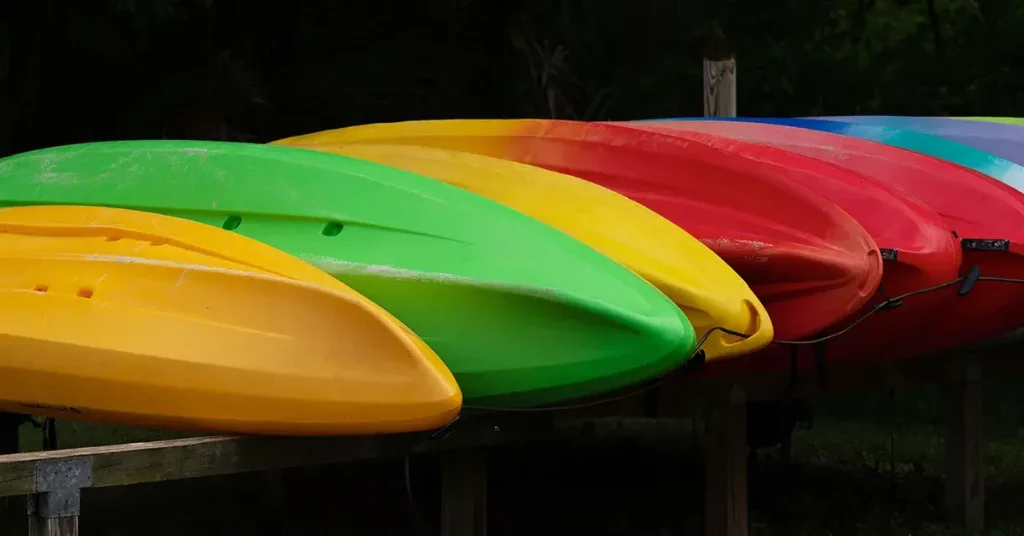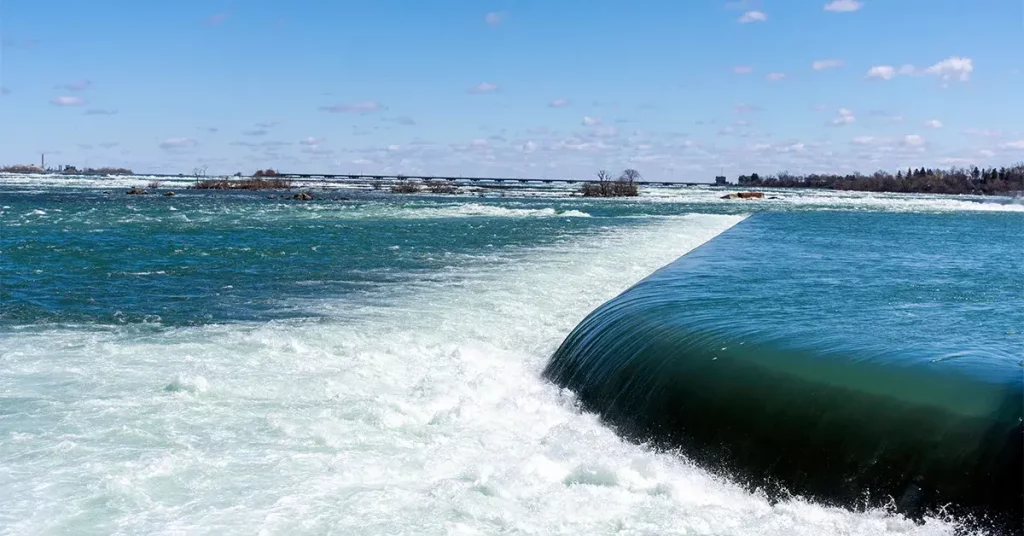Trolling for fish in a canoe or kayak can get pretty tiring! If you’ve ever tried paddling for an entire day, you’ll know exactly what I’m talking about. No matter how fit you are, sooner or later your arms turn to jelly, while you wish you were back on land with a cool drink in hand.
Mounting a trolling motor on your canoe solves this problem. Not only will a trolling motor allow you to rest your weary arms, but you’ll also be able to cover more distance and catch more fish.
There are a variety of trolling motors available for both salt and freshwater usage. Picking the right one for your canoe or kayak can be a confusing task. I’ll break down the types of trolling motors, their features and mounting options – plus how to pick the best one for your boat.
Quick Answer: 5 Best Trolling Motors for your Canoe
- Best Overall: Minn Kota Endura C2 55
- Best Saltwater Trolling Motor: Newport Vessels NV-Series 55lb
- Budget Pick: Newport Vessels NV-Series 36lb
- Short Shaft Trolling Motor: Newport Vessels Kayak Series 55lb
- Best Foot Controlled Trolling Motor: MotorGuide X3
Why do you need a trolling motor for your canoe or kayak
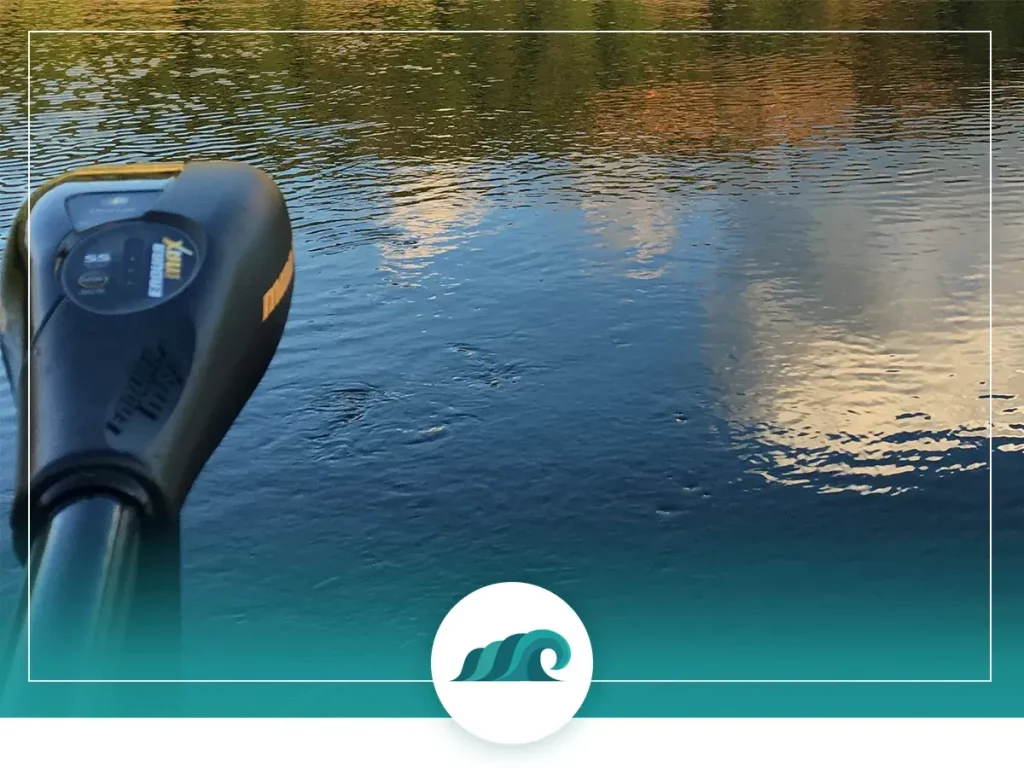
If you’re curious about trolling motors then you might already be familiar with some of their advantages.
A good trolling motor will increase the amount of distance you can cover in your canoe. Paddling is hard work. Your arms and back will eventually get fatigued, which means you’ll have to rest and recuperate from time to time.
A trolling motor allows you to set the motor to your desired speed, just like cruise control in your car. Simply set up your rod and reel, drop your line in the water, and wait for the fish to start biting. Maintaining optimum trolling speed is easier to do with an electric trolling motor than with a paddle or even an outboard motor.
Using a trolling motor also frees up one – or both – of your hands. Trying to maintain a steady speed while paddling and catching fish can be a challenging task. That’s why having a free hand to hold your rod is a huge plus.
Electric trolling motors are relatively quiet and stealthy, allowing you to effortlessly approach fish without spooking them.
In comparison with outboard motors, electric trolling motors are lightweight, less expensive, and can be used in lakes and ponds that are designated “no gas motors allowed”.
More advantages of electric trolling motors:
- Can keep your canoe or kayak in place in a current.
- Can be used as a secondary motor on larger watercraft for precise maneuvering.
- Good backup in case you lose your paddle.
- Great for fishing – helps keep your lure at the ideal depth while trolling.
Types of Trolling Motors
There are numerous types of trolling motors available on the market today, each suited to various budgets and needs.
Transom Trolling Motors
Transom trolling motors are the most common type of motor, and they attach to the back of a boat. They are most often mounted to the transom, or the rear of the boat. Depending on the manufacturer, they come in various sizes, ranging from 30-90 pounds. The motors can be electric or gas and will have between eight to 24 volts of power. Some models can reach up to 109 total pound thrust.
These motors offer plenty of torque and speed for anglers looking for control while low-drifting or maneuvering around structure. Transom trolling motors are generally easier to install than other motor types, making them an ideal option for novice anglers who don’t want all the bells and whistles but still want quality operation from their motor.
Saltwater Trolling Motors
Saltwater trolling motors are motors specifically designed for use in saltwater environments. These motors boast special features, such as stainless steel and zinc coatings, to help protect against corrosion caused by the salt water.
Not only do these specialized designs provide better performance and durability, but they also offer added convenience with shatterproof composite shafts that don’t need to be lubricated as often and are stronger than most standard fiberglass shafts.
Freshwater Trolling Motors
Freshwater trolling motors are perfect for those who frequent lakes and rivers in their fishing boat. They are designed to handle the temperature and moisture of freshwater far better than other trolling motors, making them ideal for use in these environments.
Better yet, they use a combination of thrust direction control, speed control and length controls. These features can help you manage your speed effectively, ensuring that you can stay on course and make gradual turns without losing momentum.
Bow Trolling Motors
A bow trolling motor is an electric propulsion system that can be mounted on the front of a boat and controlled by a handheld remote. These motors are ideal for providing quiet and efficient power, especially in shallow or weedy water, as they can reduce the need for a gas-powered outboard.
Bow trolling motors also allow anglers to remain stationary while casting their line into a specific spot. This makes them an invaluable tool for fishing enthusiasts. Additionally, bow trolling motors can easily move boats through tight spaces with precision and without disturbing the natural environment.
Best Overall: Minn Kota Endura C2 55
A well-made 12-volt motor from renowned manufactured Minn Kota, this 55 lbs. thrust motor is ideal for all kinds of freshwater usage. It features 5 forward speeds and 3 reverse speeds for maximum control over your craft. The quick-release lever lock bracket easily mounts to any transom and resists flexing, warping and UV damage.
Minn Kota is known for making powerful, quiet motors that last for years. This model is no exception. The composite shaft is virtually indestructible – it’s designed to flex on impact rather than breaking. Minn Kota even guarantees the shaft with a lifetime guarantee. Motor shafts are available in 3 lengths: 30”, 36” and 42”.
The 6-inch telescoping tiller tilts and extends which makes it a breeze to operate.
The entire motor is backed up by a 2-year manufacturer warranty, making this motor a perfect choice for any canoe or kayak in freshwater.
Key Features
- 5 forward speeds, 3 reverse speeds
- Virtually indestructible motor shaft, backed by a lifetime warranty
- Smooth and quiet operation
- Surprisingly powerful and long lasting
- 2-year manufacturer warranty
See Pricing On:
Best Saltwater Trolling Motor: Newport Vessels NV-Series 55lb
This ultra-quiet 55 lbs. trolling motor is a great choice for both saltwater and freshwater usage. The hardware is made of corrosion resistant stainless steel, zinc and magnesium ensuring the motor can stand up to heavy saltwater use.
5 forward speeds and 3 reverse speeds give you superb control over any watercraft. The 6-inch telescoping handle ensures you can use the motor comfortably for hours at a time.
The 30” composite fiberglass composite shaft is fully adjustable – allowing proper depth placement in all water conditions. Mounting the motor to a canoe or kayak is fairly straightforward with a tilt-adjustable mounting bracket.
A 5-point LED battery meter provides a clear battery reading – so you know how much juice you have left in your battery.
Newport includes a 2-year manufacturer warranty, so you can be assured you’re covered in case anything goes wrong.
Key Features
- Ultra-quiet and efficient motor
- 5-point LED battery meter provides feedback on remaining battery power
- Corrosion-resistant hardware can stand up to saltwater
- 2-year manufacturer’s warranty
Budget Pick: Newport Vessels NV-Series 36lb
If you’re looking for a trolling motor capable of propelling your canoe or kayak without breaking the bank, then this is a great choice. It’s almost identical in design to the Newport Vessels NV-Series 55lb motor, with a 36 lb. thrust motor instead of 55 lb.
The 36 lb. motor provides a good balance between power, efficiency, and affordability. The smaller motor provides longer run-time than bigger motors without sacrificing reliability or performance. Like other Newport Vessels’ motors – it’s ultra-quiet and allows you to approach fish without spooking them.
The motor is controlled with an 8-speed control system (5 forward speeds and 3 reverse speeds), giving you a smooth ride with precise control over speed.
Built with saltwater corrosion resistant materials, this motor allows you the freedom to use in both freshwater and saltwater. A 2-year manufacturer’s warranty comes included.
Key Features
- 36 pound thrust motor offers a good balance between power and run-time
- 2-blade compact propeller for optimal power conservation
- Saltwater corrosion resistant materials
- 5-point LED battery meter
Short Shaft Trolling Motor: Newport Vessels Kayak Series 55lb
Short shaft motors are ideal for smaller watercraft like kayaks, canoes and inflatable dinghies. The 24” fiberglass shaft offers ideal depth placement on a kayak or small canoe. Extended 5ft 6in battery cables allow for flexible battery placement – which lets you position the battery optimally inside your boat.
5 forward gears and 3 reverse gears provide precise steering and control, while a bright blue LED indicator ensures you know exactly how much run time is left in your battery.
The entire unit is rated for saltwater use, with an aluminum motor head and corrosion resistant magnesium, zinc, and stainless-steel hardware. Its ultra-quiet motor operation allows you to get in close to fish without spooking them – something bigger boats can only dream of.
Newport Vessels backs up the motor with a 2-year manufacturer’s warranty.
Key Features
- 24” short shaft is ideal for kayaks and small watercraft
- Extended battery cables allow optimal battery placement
- Saltwater rated
- Ultra-quiet motor allows you to stealthily approach fish without spooking them
Best Foot Controlled Trolling Motor: MotorGuide X3 Bow Mount Foot-Controlled Trolling Motor
This foot-controlled freshwater trolling motor allows for completely hands-free operation, which leaves your hands open to catch more fish.
The motor is made from high-quality materials – a rigid aircraft grade aluminum mount keeps the unit secure while stainless steel bushings and bearings ensure long-term performance. The foot control unit utilizes an ergonomic heel/toe design which allows for precise control over your boat.
A patented variable-ratio steering system lets you accurately position your boat even in choppy, windy conditions. The system works by increasing directional change as you increase pressure on the foot control unit.
Available in 45, 55 and 70 lb. thrust motors, this motor has enough thrust to power larger watercraft, but can be mounted on a bigger canoe as well.
The motor is backed by a 2-year manufacturer’s warranty.
Key Features
- Aircraft grade aluminum mounting bracket minimizes flex
- Rugged composite shaft provides impact protection and has a lifetime warranty
- Precision response steering improves steering responsiveness
- Hands-free operation
- Whisper quiet on the water
See Pricing On:
What are electric trolling motors
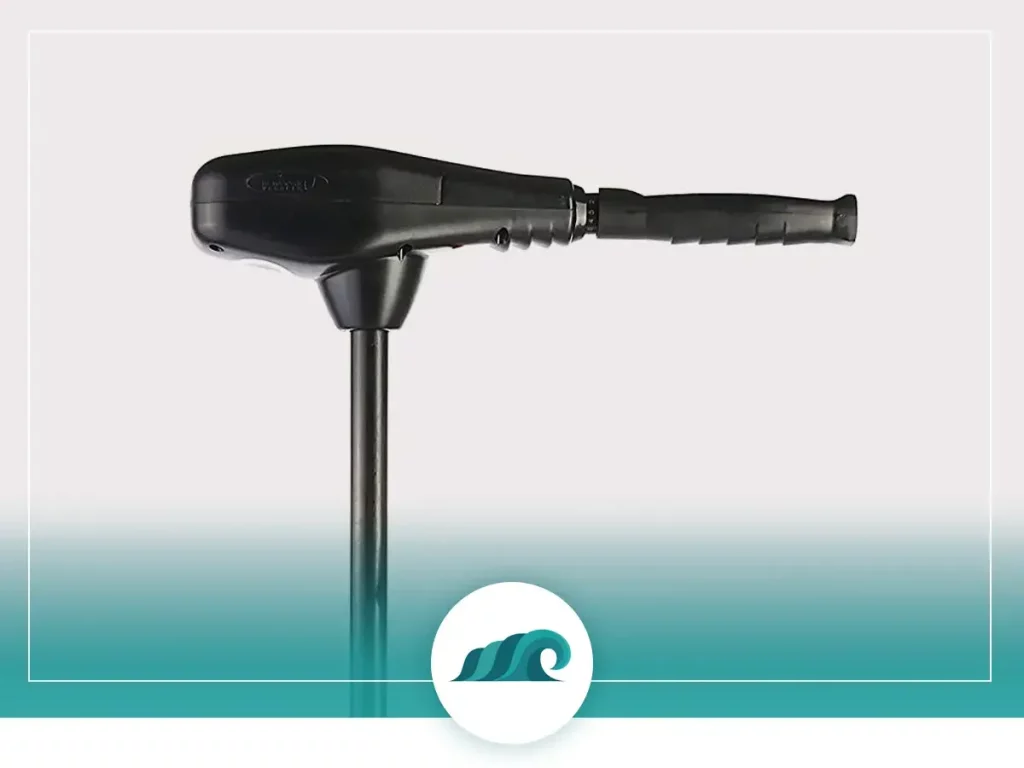
Electric trolling motors are self-contained propulsion units which include a motor, propeller, and controls. They’re mounted on either the bow (front) or stern (rear) of a watercraft. For canoes and kayaks, they’re typically mounted on the stern.
The name “trolling” comes from the fishing technique where fishing lines are drawn through the water by a moving boat. Trolling motors are ideal for fishing but have many other uses as well.
Modern electric trolling motors are highly efficient and can typically operate all day without needing to be recharged. The variable speed controls and reverse allow you to precisely control the speed and direction of your craft. Their lightweight design means you can easily lift the motor out of the water while loading/unloading or if you need to clear obstacles in shallow water.
Trolling Motor Components
Motor
Modern electric trolling motors are typically 12, 24 or 36 volt brushed motors. For canoes, a 12v motor should provide more than enough power for most situations.
The motor itself is mounted inside a watertight compartment at the base of the unit. It’s fully submerged when in use. This design is ideal for lightweight boats like canoes and kayaks, as it takes up less space inside the hull.
Controls
There are three control types typically used in electric trolling motors: Hand control, foot control, and wireless control.
Hand controlled motors are easy to use, relatively inexpensive, and can be mounted directly to your boat. They do require one hand to operate, so if you want hands-free operation look into a foot or remote control.
Foot controlled motors have on/off and speed controls operated by your foot. This allows total hands-free operation, which is great for fishing. They’re typically more expensive than hand controlled motors and are found in motors for larger watercraft. They also require a specialized mounting bracket to install.
Foot controls can be difficult to coordinate for some people, so fishing with them requires a little practice.
Wireless remote controlled motors are the most expensive and are typically found in high-end models. They can be controlled with either a foot pedal or a hand operated remote control.
Propeller
The propeller is fitted directly to the motor’s prop shaft. This means the power coming out of the motor transfers into the propeller without any power reduction. This design leads to increased efficiency, reduced noise, and precise control.
Propellers typically have three blades, but there are some models available with fewer or more blades.
How to pick the right trolling motor for your canoe
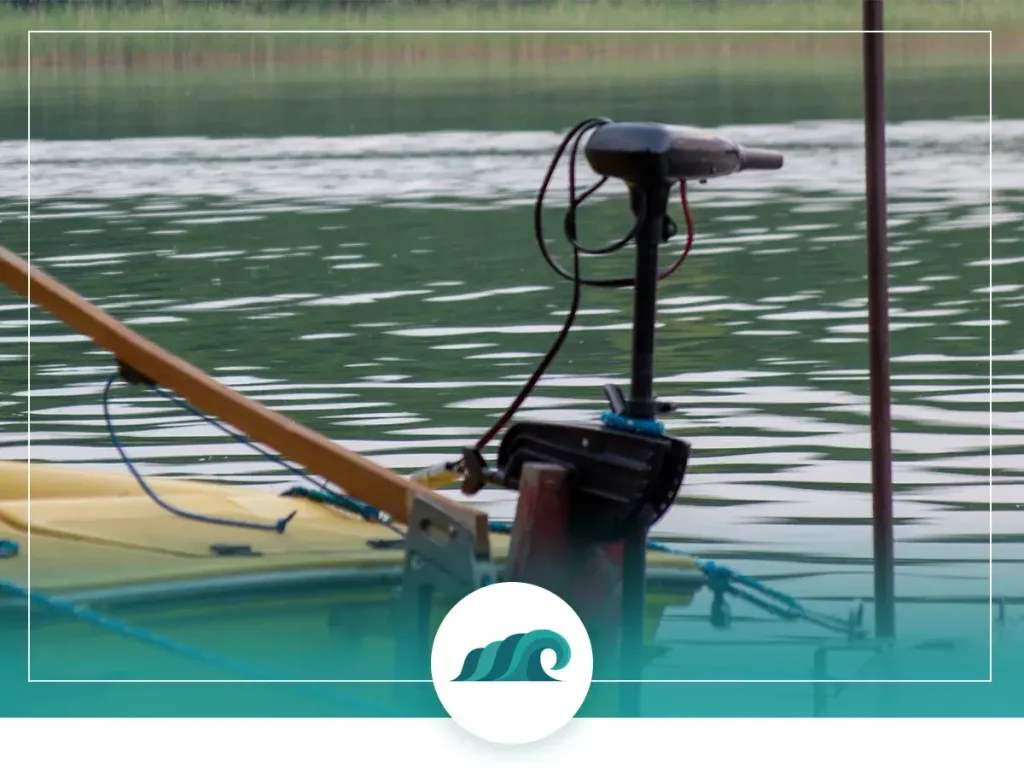
The right trolling motor for your canoe or kayak will depend on a number of factors.
Do you plan to use the motor in saltwater, freshwater or both? How heavy is your watercraft? How much power are you looking for?
Saltwater vs. Freshwater
There are significant differences between the design of saltwater and freshwater motors.
Saltwater motors are typically made with stainless steel hardware, sealed electrical connections and corrosion resistant paint. Freshwater motors do not have these features, so using a freshwater motor in saltwater can cause corrosion and damage the motor.
Using a freshwater motor in saltwater will often void the manufacturer’s warranty. Read the fine print on your motor’s warranty to be sure.
If you do decide to use a freshwater motor in saltwater, be sure to thoroughly rinse the entire motor with fresh water and dry after each use. Spraying with some WD-40 before and after will help protect the motor as well.
Saltwater motors can be used in freshwater without any problems.
Canoe size
The size and weight of your canoe will determine the size motor you’ll need.
For most canoes, a 55-lb thrust motor will provide more than enough power to haul a fully loaded boat. Smaller 30-40 lb thrust motors will work fine for smaller loads, plus they’ll drain your battery at a slower rate.
Shaft Length
The ideal shaft length will place the motor and propeller approximately 1 foot below the water. This length gives you efficient propulsion without being so long that you hit the bottom in shallow water.
Pounds of thrust and voltage
Power from electric trolling motors is rated in pounds of thrust rather than horsepower.
The amount of power you’ll need will depend on the weight of your boat, the wind conditions, and any currents. As a general rule of thumb, select a motor with at least 2lbs. of thrust for every 100lbs. of boat weight.
For most canoes and kayaks, a 55 lb motor will provide more than enough thrust.
Trolling motors are available in several different voltages: 12v, 24v and 36v are common. For a smaller boat, 12v is ideal – it provides enough power while not draining the battery too quickly.
Propeller
It is important to note that a bigger propeller means more thrust, but that it also means more resistance when moving through the water. Smaller propellers let you move through the water with less drag, although they might struggle to power you against strong currents.
If you will be using your canoe mainly in inland waters such as lakes, a larger prop may not be necessary since it won’t be dealing with as much resistance from currents. On the other hand, if you plan to take your vessel out in open bodies of water such as rivers or oceans, then a larger prop might be necessary.
Controls
One of the most important factors to consider is the type of controls. There are two main varieties: hand controls and foot controls.
Hand-controlled motors are simpler to operate, making them ideal for casual boaters who aren’t expecting challenging or particularly intricate tasks. Foot-controlled motors provide more fine control, which is great for anglers and other experienced boaters who need both ultimate accuracy and power.
Ultimately, selecting the right motor will depend on your individual needs and preferences in a trolling motor.
Mounting Ability
The way in which the motor will securely attach is crucial, so make sure you know the exact ways in which it mounts before you buy. Different motors might require gunwales or transom mounting, and some may come with necessary hardware like clamps or brackets.
It’s also important to inspect the mounting area on your canoe for obstructions that may prevent proper attachment, as well as any damage that could hinder mounting ability. This isn’t an aspect that should be overlooked when selecting a trolling motor for your canoe.
Maintenance
While spending a bit more up front may save money in the long run, it’s important to think about how much you can realistically maintain the trolling motor and its components. The more complex and feature-rich motors tend to require significantly more upkeep than simpler units.
Additionally, look at parts availability in your area; some parts are harder to come by than others. This should be taken into account when making a purchase decision.
Ultimately, if you understand what level of maintenance your trolling motor requires and have an accurate idea of how often you will be able to commit to its servicing, picking the right option for your canoe should be much easier.
Mounting your trolling motor
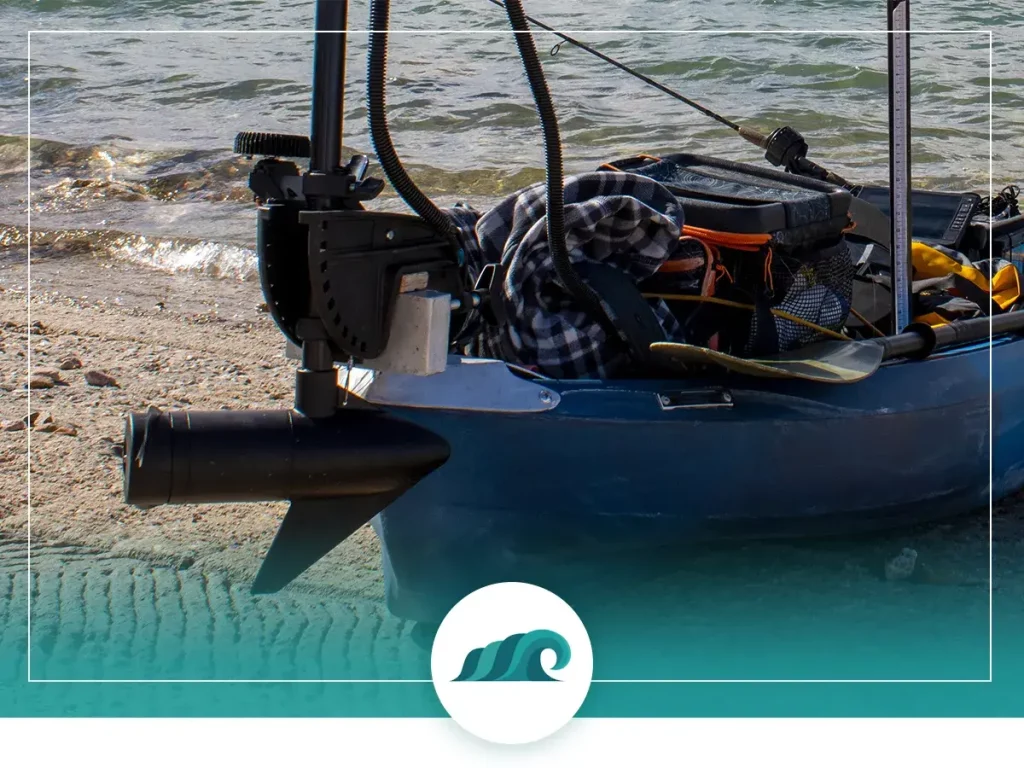
Trolling motors can be mounted in either the bow (front) or stern (rear) of a canoe or kayak. In smaller watercraft, these motors are typically mounted in the stern. This allows easy control over the boat and lets you steer facing forwards.
Larger boats that use a trolling motor as a secondary means of propulsion will often mount in the bow.
Mounting a trolling motor on a canoe is fairly straightforward. Most canoes don’t come with a flat transom (the flat surface forming the stern of a boat) for mounting a motor, but with a 2” x 4”, some steel bolts and a little DIY, you can easily mount a trolling motor to any canoe.
If you don’t want to bother with that, there are also specialized mounting brackets available for canoes and kayaks. They’re typically made of anodized aluminum and are mounted to the gunwales using adjustable angle clamps. These allow you to quickly mount and dismount the motor and rapidly pack everything away for transport.
Maintenance
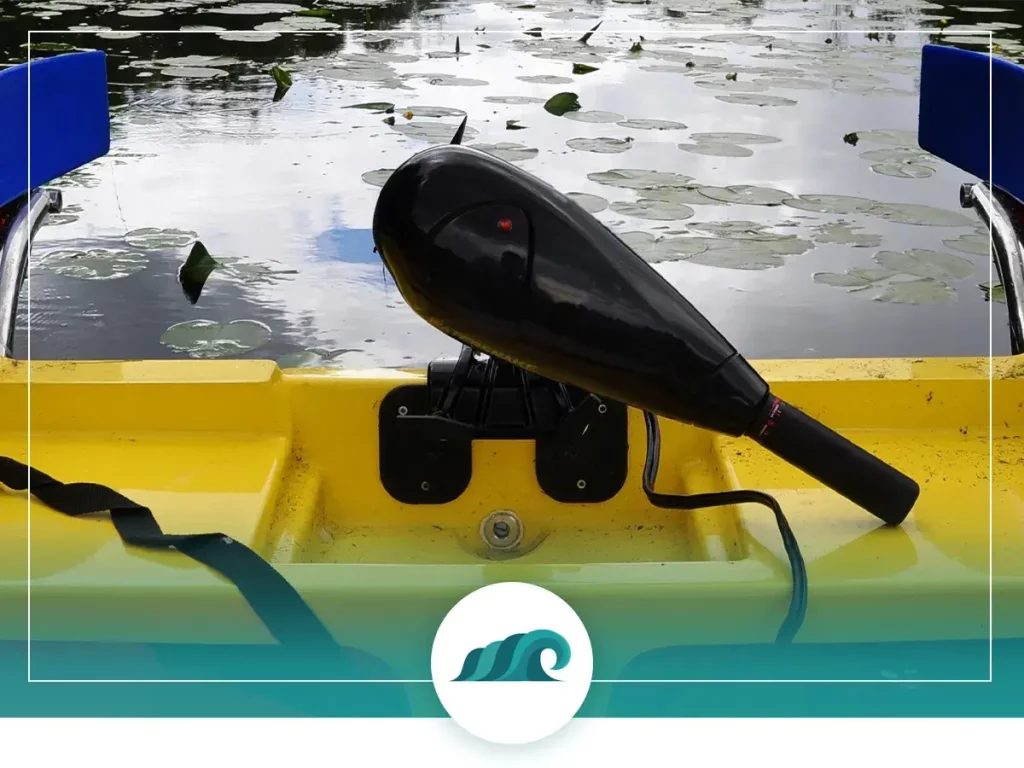
Trolling motors are generally pretty low maintenance, but following a few key steps will ensure you get the most out of your motor.
- Don’t leave the motor hooked into the power source when not in use for extended periods of time. This can lead to corrosion of the battery terminals.
- Give the motor and propeller a good rinse in fresh water after each use. This is especially important if you use your motor in saltwater.
- Check the propeller for weeds or fishing line that might have become entangled. These can stress your motor and cause it to overwork.
- Apply some marine-friendly lubricant spray to the shaft and all moving parts to keep them well lubricated and protected from corrosion.
- Recharge your battery to full after each use to extend the battery life.
Is It Legal to Put a Trolling Motor on a Kayak?
Putting a trolling motor on your kayak is a legal option depending on the state you reside in. It can give you some extra power on long paddles and also provide more control when facing a strong current or wind.
Generally, if you are going to put a trolling motor on your kayak, it will need to be registered with your local government the same way that would register any other kind of boat. Depending on where you live, the cost and rules surrounding registration vary, so be sure to research what is required for your location.
In most instances, you do not need to provide proof of ownership such as a DMV registration. However, if the craft is bigger than 12-14 feet and has an outboard motor of 10 HP or more, then this rule no longer applies. The only exception would be when using a trolling motor on private lakes and ponds. It is important to be aware of laws and regulations in order to safely utilize any type of watercraft.
Wrapping it All Up
If you fish from your canoe or kayak frequently, then getting a trolling motor to mount on your boat is a no-brainer.
A trolling motor makes a great addition to any canoe or kayak – it enables you to cover more distance, maintain a constant speed while fishing, and allows you to rest your arms when you get tired of paddling.
Advancements in trolling motor technology have made them cheaper and more efficient than ever before. Modern trolling motors are highly efficient and draw far less battery power than older models.
If you spend a lot of time fishing in the wild, check out my reviews of fishing face masks and survival fishing kits.
FAQ’s
Do you need to register a canoe with a trolling motor?
In most states, you will need to register your canoe when you mount a trolling motor on it. This includes both electric and gas trolling motors.
How long will a battery last with a trolling motor?
This depends on a number of factors, such as the weight of the boat, weather conditions, and age of the motor. A newer model 12-volt motor mounted on a canoe or kayak should last well over 8 hours of moderate usage in normal weather conditions.
How fast will a 55 lbs. thrust trolling motor go?
Top speed will depend on boat weight, hull shape, and length-to-beam ratio. Typically a 55 lbs. trolling motor mounted on a canoe or kayak will top out at 4 – 6 mph.
What kind of battery do you need for a trolling motor?
A deep cycle marine battery is needed for a trolling motor. Car batteries are not appropriate for use with trolling motors; they will not last long and can damage the motor.
What is the point of a trolling motor?
What is the standard voltage for trolling motors?
When it comes to trolling motor voltage, there are a few standards. To ensure their motor operates properly, boaters must consider the standard voltages available for trolling motors – 12 volt, 12/24 volt, 24 volt and 36 volt. Choosing the right voltage is essential for reliable operation since every model of trolling motor was specifically designed to run on its intended voltage
What is the difference between a 12v and 24V trolling motor?
The key difference between a 12v and 24v trolling motor is the amount of thrust it generates. In general, a 24v trolling motor will provide double the amount of thrust as a 12v model, allowing it to handle larger boats with bigger loads more effectively. However, this increased performance comes at an increased cost for purchasing and operating the 24v model. For smaller boats with lighter loads, a 12v model may be preferable to keep costs down while still providing the necessary thrust.
Is more thrust better on a trolling motor?
More thrust may not always be the better option when it comes to selecting the right trolling motor for your boat. Factors such as the weight of your boat and its intended use should also be taken into consideration. Higher thrust motors may provide more power, but can also create additional drag on lighter boats or when used in shallow waters. On the other hand, higher thrust motors can come in handy when fishing with multiple anglers abroad and in rougher waters.
Is it possible to install a trolling motor on a kayak?
It’s absolutely possible to install a trolling motor on a kayak! Many water-lovers are discovering the benefits of installing a trolling motor on their kayak. It’s a great way to add both speed and maneuverability to your paddling experience, allowing you to reach your destination faster and with greater control than ever before. In terms of effort, it requires no more than adjusting the mounting bracket and attaching the motor.
Can you put a trolling motor on an inflatable kayak?
Adding a trolling motor to an inflatable kayak is totally doable! However, it is important to check the product instructions carefully before attempting to install the trolling motor on the inflatable kayak; this will ensure that the kayak can safely support this added weight and that the angle of the trolling motor is correct for optimal performance.
How deep should the trolling motor be in water?
The depth of a trolling motor in water should be at least 12 inches. This ensures that it is not pulled under when traveling on the water and can withstand occasional impacts. Additionally, it will ensure the motor remains operational in extreme weather conditions such as high winds or large waves that could submerge less deeply mounted motors.
Does shaft length matter on a trolling motor?
Shaft length is an important factor when you’re getting a trolling motor, since it will determine the depth at which your boat will stay in the water. Generally speaking, the deeper you need to be in the water for fishing or other purposes, the longer shaft length you want to choose.



